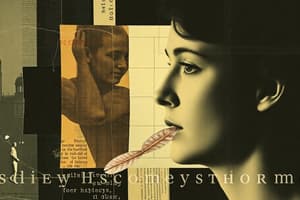Podcast
Questions and Answers
According to research, what is the primary source of wrongful convictions?
According to research, what is the primary source of wrongful convictions?
- Inaccurate eyewitness identification (correct)
- Inaccurate forensic analysis
- Ineffective legal counsel
- Coerced confessions
Which of the following best describes the misinformation effect?
Which of the following best describes the misinformation effect?
- A witness's inability to recall specific details of a crime due to stress.
- The alteration of a person's memory of an event by misleading information presented after the event. (correct)
- The misattribution of the source of a memory, leading to confusion about where the memory originated.
- The tendency for witnesses to focus on a weapon during a crime, impairing their memory of other details.
What is the primary characteristic of the source effect in eyewitness memory?
What is the primary characteristic of the source effect in eyewitness memory?
- Focusing on the weapon and missing other details
- Mixing up where the memory came from (correct)
- Forgetting details immediately after the event
- Altering of memory by misleading info
How does the weapon focus effect impact eyewitness accuracy?
How does the weapon focus effect impact eyewitness accuracy?
Which identification procedure generally leads to more accurate eyewitness identifications when conducted properly:
Which identification procedure generally leads to more accurate eyewitness identifications when conducted properly:
What is a key factor that makes showups more prone to error than lineups?
What is a key factor that makes showups more prone to error than lineups?
Under what conditions is eyewitness confidence most likely to correlate with the accuracy of identification?
Under what conditions is eyewitness confidence most likely to correlate with the accuracy of identification?
What procedure is LEAST likely to improve the accuracy of eyewitness identification?
What procedure is LEAST likely to improve the accuracy of eyewitness identification?
Which of the following is NOT a recommended practice for improving eyewitness accuracy?
Which of the following is NOT a recommended practice for improving eyewitness accuracy?
What is a key characteristic of a pristine lineup, designed to increase the accuracy of eyewitness identification?
What is a key characteristic of a pristine lineup, designed to increase the accuracy of eyewitness identification?
Which of the following is a criterion outlined in the Manson v. Braithwaite case for evaluating the accuracy of eyewitness testimony?
Which of the following is a criterion outlined in the Manson v. Braithwaite case for evaluating the accuracy of eyewitness testimony?
According to the ruling in U.S. v. Wade (1967), what right does a suspect have during a post-indictment lineup?
According to the ruling in U.S. v. Wade (1967), what right does a suspect have during a post-indictment lineup?
What is a key attribute of cyber-dependent crimes?
What is a key attribute of cyber-dependent crimes?
Which type of cybercrime can ONLY occur in a digital environment?
Which type of cybercrime can ONLY occur in a digital environment?
What situational factor is most likely to trigger the use of heuristic thinking?
What situational factor is most likely to trigger the use of heuristic thinking?
How does the representativeness heuristic influence judgment?
How does the representativeness heuristic influence judgment?
What does the availability heuristic primarily rely on when making judgments?
What does the availability heuristic primarily rely on when making judgments?
What is a common warning sign indicating a potential romance scam on a dating app?
What is a common warning sign indicating a potential romance scam on a dating app?
What cognitive or emotional factor increased the risk of being victimized by phishing attacks, according to Stalans et al. (2024)?
What cognitive or emotional factor increased the risk of being victimized by phishing attacks, according to Stalans et al. (2024)?
How is the representative heuristic used by cybercriminals in phishing attacks?
How is the representative heuristic used by cybercriminals in phishing attacks?
Flashcards
Misinformation effect
Misinformation effect
Memory altered by misleading information after the event.
Source effect
Source effect
Misattributing the source of a memory; remember the fact, forget where from.
Weapon focus effect
Weapon focus effect
Focus on weapon reduces ability to recall other details.
Lineups
Lineups
Signup and view all the flashcards
Showups
Showups
Signup and view all the flashcards
Manson criteria
Manson criteria
Signup and view all the flashcards
Alford Plea
Alford Plea
Signup and view all the flashcards
Cyber-dependent crime
Cyber-dependent crime
Signup and view all the flashcards
Cyber-enabled crime
Cyber-enabled crime
Signup and view all the flashcards
Pure cybercrime
Pure cybercrime
Signup and view all the flashcards
Representative heuristic
Representative heuristic
Signup and view all the flashcards
Availability heuristic
Availability heuristic
Signup and view all the flashcards
Representative heuristic in cybersecurity
Representative heuristic in cybersecurity
Signup and view all the flashcards
Availability heuristic in cybersecurity
Availability heuristic in cybersecurity
Signup and view all the flashcards
Duping delight
Duping delight
Signup and view all the flashcards
Othello error
Othello error
Signup and view all the flashcards
Ostrich effect
Ostrich effect
Signup and view all the flashcards
Characteristics related to detecting deception
Characteristics related to detecting deception
Signup and view all the flashcards
Study Notes
Eyewitness Identification
- Inaccurate eyewitness identification is the primary cause of wrongful convictions.
Misinformation, Source, and Weapon Focus Effects
- The misinformation effect occurs when a person's memory is altered by misleading post-event information.
- The source effect is when someone misattributes the source of a memory and confuses its origin.
- The weapon focus effect is when a witness focuses on a weapon during a crime, which reduces their ability to recall other details.
Lineups vs. Showups
- Lineups, especially double-blind and sequential ones, are more accurate.
- Showups have a higher risk of false identification due to suggestiveness.
Eyewitness Confidence and Accuracy
- Eyewitness confidence and accuracy are related during initial, immediate identifications, high-quality viewing conditions, and proper lineups.
- Confidence and accuracy are not related after suggestive feedback, a long time between the event and identification, and poor viewing conditions.
Improving Eyewitness Accuracy
- Double-blind and sequential lineups improve accuracy.
- Avoiding confirming feedback and using non-leading instructions are essential.
- Avoiding multiple identifications and cognitive interviews helps.
Five Pristine Conditions for Accurate Witness Identification
- Only one suspect should be in a lineup at a time.
- The suspect should not stand out in the lineup.
- Unbiased instructions should be given to the witness.
- A double-blind procedure should be used.
- An immediate confidence statement should be taken from the witness.
Manson Criteria
- The Manson criteria are used to evaluate eyewitness testimony accuracy.
- The criteria include the opportunity to view the suspect, the degree of attention, the accuracy of prior description, the level of certainty, and the time elapsed.
U.S. vs. Wade (1967)
- A suspect has the right to legal counsel during a post-indictment lineup based on the Sixth Amendment.
General Conclusions About Eyewitness Accuracy
- Memory can be reconstructive.
- Higher witness confidence typically indicates better accuracy.
- The quality of viewing conditions matters.
Cybercrime
- Cybercrimes are primarily traditional crimes committed in a virtual space.
Cyber-dependent, Cyber-enabled, and Pure Cybercrimes
- Cyber-dependent crimes can only be committed using computers and digital technology.
- Cyber-enabled crimes are traditional crimes using digital technology.
- Pure cybercrimes can only happen in a digital environment, e.g., hacking.
- Hacking is an example of a pure cybercrime, involving illegal access to a computer system to steal data.
Situational Features Triggering Heuristic Thinking
- Time pressure, uncertainty, stress, emotion, familiarity, and multitasking trigger heuristic thinking.
Representative and Availability Heuristics
- The representative heuristic is a mental shortcut where people judge events based on similar past situations.
- The availability heuristic is when judgments about an event's likelihood are made based on how easily examples come to mind.
Warning Signs of a Romance Scammer
- Excessive flattery or fast attachment.
- Asks for money.
- Inconsistent or minimal personal details.
Stalans et al (2024) Phishing Study Findings
- People with low avoidant decision-making and high anxiety are four times more likely to be phishing victims.
- Using protective email strategies and avoiding vulnerable ones can reduce the risk of phishing.
Cybersecurity and Heuristics
- The representative heuristic tricks hackers by using similar-looking emails/websites from trusted brands.
- The availability heuristic is by using recent news events to make messages seem real and recent.
Confessions and Interrogations
- Body movements are unreliable indicators of whether someone is lying.
Video Recording of Custodial Interrogations
- 25 states and D.C. mandate the video recording of custodial interrogations.
Written Confessions from Minors in Illinois
- Written confessions from minors are prohibited without a guardian or attorney present.
- Prohibited if there's a failure to waive Miranda rights.
- Prohibited if coercion or unfair interrogation is used.
Interrogation Techniques
- Showing evidence is a technique more likely to make the guilty confess but not the innocent.
- Manipulating the context is a technique more likely to make the guilty confess but not the innocent.
- Building rapport with the suspect is a technique more likely to make the guilty confess but not the innocent.
- Strategic use of questions is a technique more likely to make the guilty confess but not the innocent.
Tactics Increasing Likelihood of Guilty Confessions
- Confrontation with evidence.
- Minimizing the crime.
- Offering sympathy.
- These tactics increase guilty confessions without similarly affecting innocent individuals.
Illinois Policy Changes to Reduce False Confessions
- Banning deceptive interrogation tactics for minors reduces false confessions.
- Mandatory video recording of custodial interrogations reduces false confessions.
Interrogation Decision-Making Model
- Suspects decide whether to confess or deny involvement in a crime during interrogation.
- Decisions are based on assessments of evidence, consequences, interrogation tactics, and personal factors.
Alford v. North Carolina
- Alford v. North Carolina allows a defendant to plead guilty while maintaining innocence to avoid a harsher sentence.
- The Alford Plea allows defendants to plead guilty without admitting guilt, accept conviction, and acknowledge sufficient prosecution evidence.
Deception
Increasing Lie Detection
- Lie detection can be increased through the devil's advocate question, turn-taking in interviewing, cognitive load, unanticipated questions, and repeating questions.
Duping Delight, Othella Error, Ostrich Effect, and Self-Fulfilling Fakery
- Duping delight is the pleasure a liar feels after successfully lying.
- Othella is the error of a truthful person appearing nervous/anxious is mistakenly judged as lying.
- The ostrich effect is the tendency to avoid negative or distressing information.
- Self-fulfilling fakery is when pretending to have a trait leads to actually developing it.
Polygraph Evidence in Court
- Over half of U.S. states ban polygraph evidence in court.
Characteristics Related to Detecting Deception
- Truthful individuals tend to answer questions directly, relevantly, and clearly.
- Subjective impressions outweigh objective measures, although gut feelings are not always accurate.
Ways to Increase Deception Detection
- Ask unexpected questions
- Encourage longer responses
- Pay attention to verbal and nonverbal responses
- Look for emotional leakage
Peer et al. (2014) Findings on Partial Confessions
- Partial confessions can increase guilt feelings rather than reducing them.
- People giving partial confessions often feel worse than those fully confessing.
- Observers often view partial confessions as suspicious.
Studying That Suits You
Use AI to generate personalized quizzes and flashcards to suit your learning preferences.




